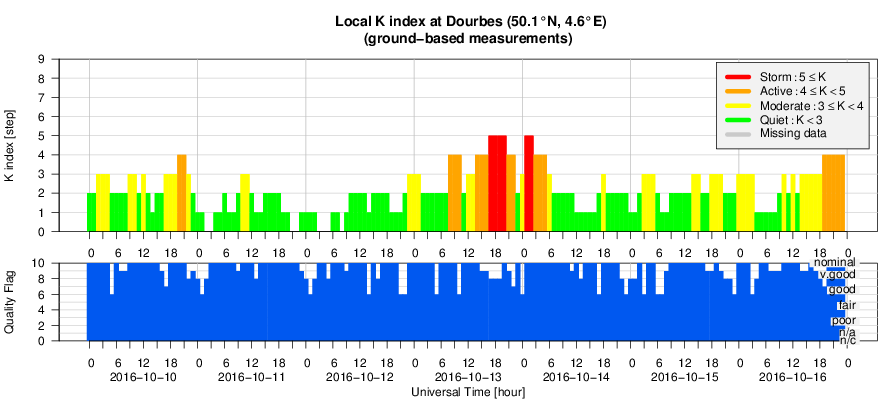- Table of Content
- 1.Sunspot gets a...
- 2.Catch by surpr...
- 3.PROBA2 Observa...
- 4.Review of sola...
- 5.The internatio...
- 6.Review of geom...
- 7.Geomagnetic Ob...
- 8.Review of iono...
- 9.Future Events
2. Catch by surprise - stealth CME
3. PROBA2 Observations (10 Oct 2016 - 16 Oct 2016)
4. Review of solar activity
5. The international Sunspot Number
6. Review of geomagnetic activity
7. Geomagnetic Observations at Dourbes (10 Oct 2016 - 16 Oct 2016)
8. Review of ionospheric activity (10 Oct 2016 - 16 Oct 2016)
9. Future Events
Sunspot gets a facelift
NOAA 2599 transited the solar disk from 3 till 15 October. It reached its largest size around 5 October, when its area was equivalent to nearly 3 times the total surface area of the Earth. During its transit, it significantly changed from outlook, becoming smaller and less complex. Solar observers watching the Sun only at the beginning and the end of the period might even have had a hard time to conclude this was the same sunspot.
The SDO/HMI imagery underneath shows the spot on 4, 8 and 13 October. Its shape-shifting is even clearer in the movie at https://youtu.be/SegJCug4zrg , with an image cadence of about 1 image per half hour. There's an unfortunate gap in the imagery between 10 and 13 October. The ridges that can be seen crossing the sunspot, in particular on 8 October (middle image), are no white light flares but light bridges. These photospheric ("solar surface") features usually herald the dissolution of the spot.

NOAA 2599 was actually a flare inactive region, producing only a couple of B-class flares and, on 12 October, a single C1 flare. It is therefore all the more interesting that just after midnight on 17 October, while the region was already a full day behind the western solar limb, an important C4 flare was observed from what appears to be the probable location of NOAA 2599. Without imagery, we will never know for sure of course. No obvious associated coronal mass ejection was observed in coronagraphic images.

Catch by surprise - stealth CME
On Oct 13, an alert was sent by the RWC/SIDC Belgium: 'A shock was detected in the solar wind around 21:22UT October 12 which marks the earlier then expected arrival of the October 9 CME. ...'
A few hours later : ' Following the October 9 CME arrival, the persistent negative Bz component of the interplanetary magnetic field at levels around -10nT since 5:30UT is causing geomagnetic indices to reach minor storm levels (NOAA Kp=5 while local K Dourbes 4). As total magnetic field is still rising (currently around 18nT) and negative Bz values may persist ...'
How did the story go?
On Oct 10, the RWC/SIDC Belgium warned for a full halo CME seen by SOHO early on October 9. But the speed was thought to be small, at most 300 km/s. It was not expected before October 13 and the Earth was likely to be located at the edge of the CME passage.
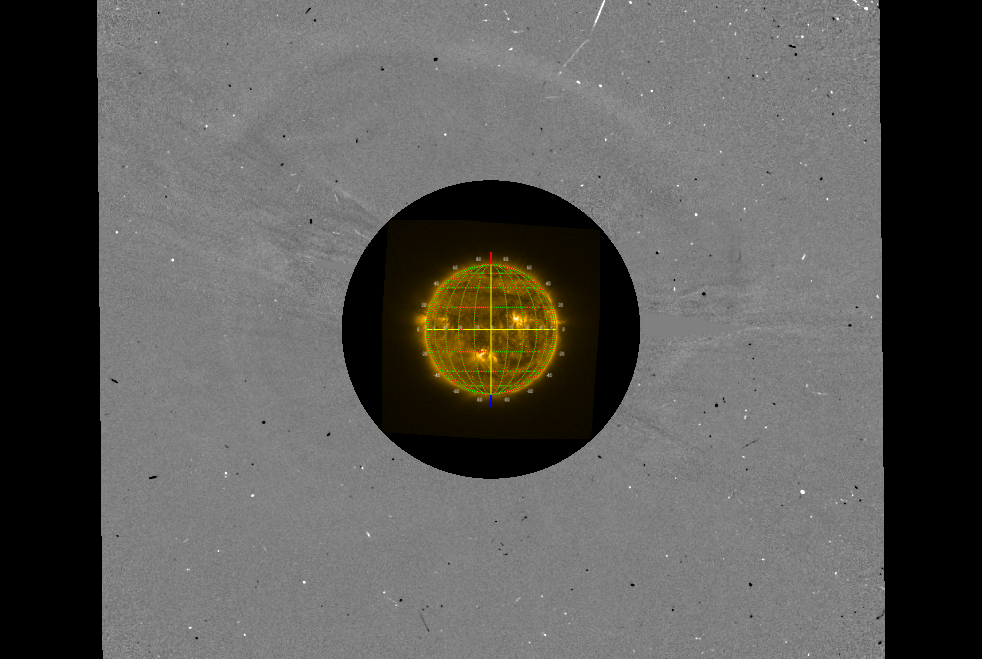
Check the movie: http://www.stce.be/movies/JHV_2016-10-21_08.49.30.mp4
And here a movie with difference images: http://www.stce.be/movies/JHV_2016-10-21_08.49.47.mp4
On Oct 12, around 21:22UT at the L1 point, a shock in the solar wind was detected. The magnetic energy carried by the solar wind increased slowly but steady. A CME in combination with the fast solar wind emanating at that moment from a negative coronal hole could be the recipe for a geomagnetic impact.
The event caught the attention of several scientists and sparked the discussion about stealth CMEs. The 'launch site' of stealth CMEs is sort of mysterious as a solar disk trigger is apparently absent or very vague. These CMEs look faint and give the impression of not being harmful. But when they mingle with other CMEs and fast streams, they might catch us by surprise.
PROBA2 Observations (10 Oct 2016 - 16 Oct 2016)
Solar Activity
Solar flare activity fluctuated between very low and low during the week.
In order to view the activity of this week in more detail, we suggest to go to the following website from which all the daily (normal and difference) movies can be accessed: http://proba2.oma.be/ssa
This page also lists the recorded flaring events.
A weekly overview movie can be found here (SWAP week 342).
http://proba2.oma.be/swap/data/mpg/movies/weekly_movies/weekly_movie_2016_10_10.mp4
Details about some of this week’s events, can be found further below.
If any of the linked movies are unavailable they can be found in the P2SC movie repository here
http://proba2.oma.be/swap/data/mpg/movies/
October 12-14
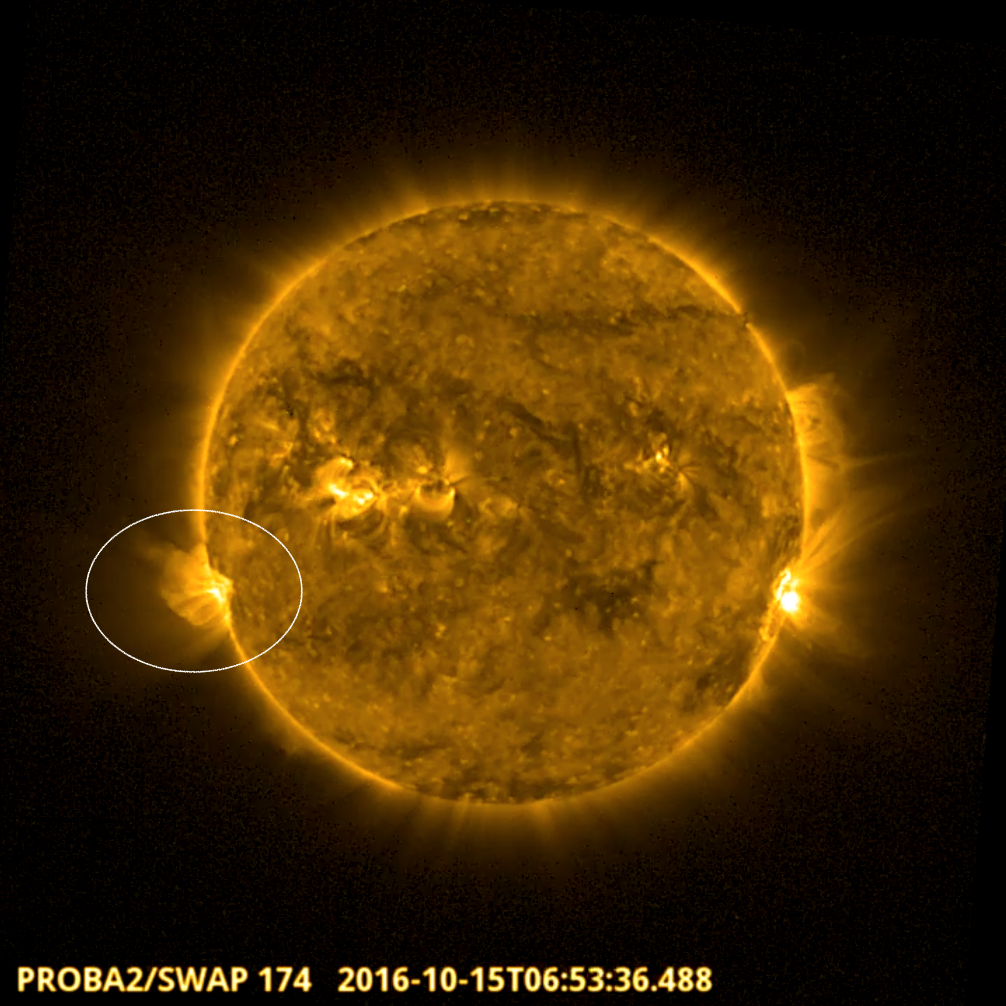
Active Region 2599 was most active through the week producing C class flares. The region
transited the solar disk and can be seen in the image above on 2016-Oct-12
Find a movie of the events here (SWAP movie)
http://proba2.oma.be/swap/data/mpg/movies/20161012_swap_movie.mp4
Friday Oct 14
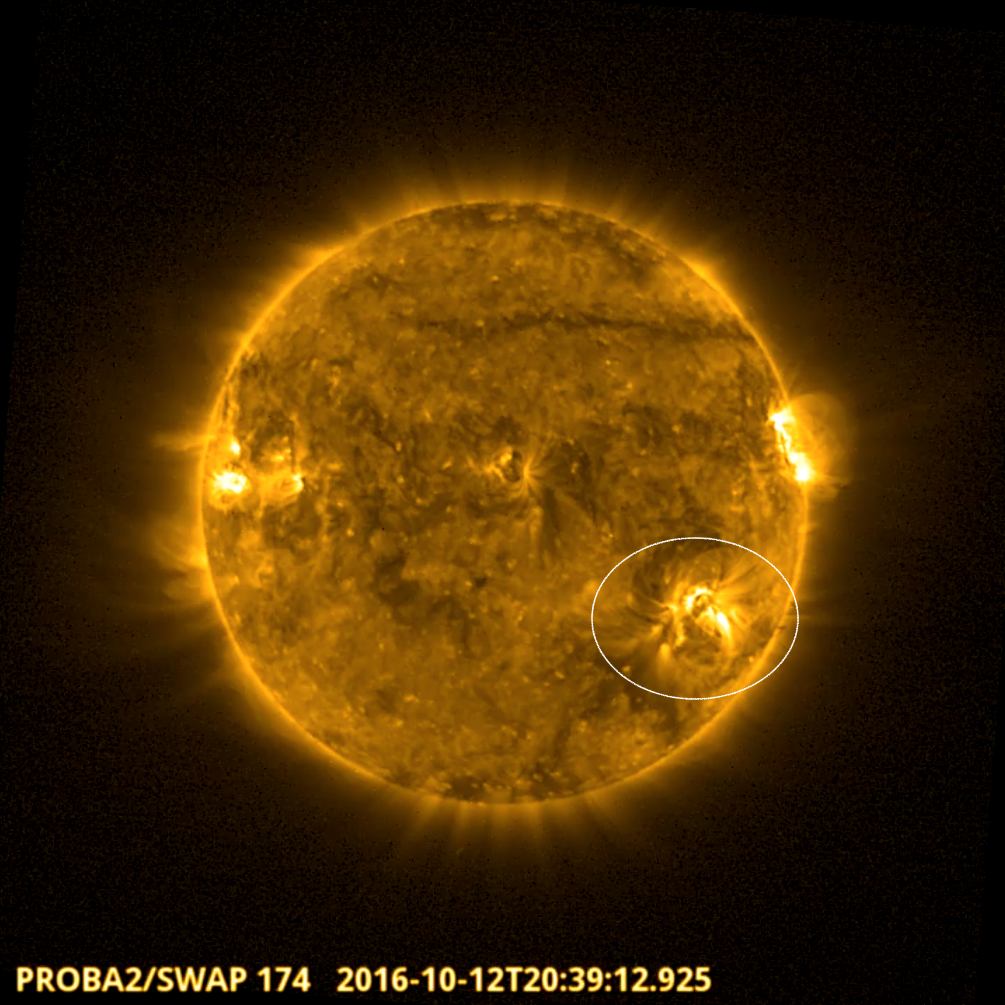
A CME was produced from an Active Region located on the East limb at 20:39 UT on
2016-Oct-12. The eruption produced a set of large post eruption loops seen throughout
2016-Oct-15
Find a movie of the event here (SWAP movie)
http://proba2.oma.be/swap/data/mpg/movies/20161014_swap_movie.mp4
Review of solar activity
Solar activity was low with only 3 C flares occurring over the period: a C1.1 flare from Catania group 42 (NOAA region 2599) on October 12 and a C1.3 and C1.0 flare from at the South-East limb on October 13 and October 14.
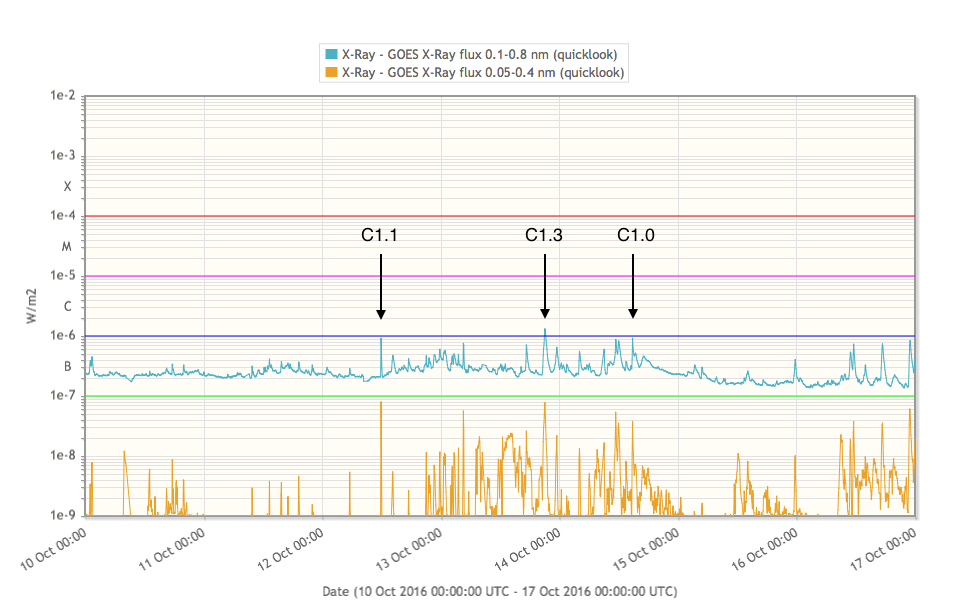
The solar proton flux was at background levels throughout the week.
A full halo CME was visible in SoHO/LASCO C2 images from 2:00 UT onwards on October 9. The animated gif below shows LASCO C3 images.
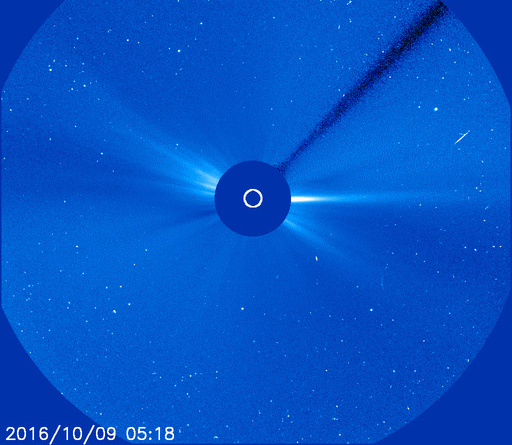
The ejection was mostly directed towards the North-East and had an angular extent of 360 degrees (although the South-West component is only very faint, causing Cactus to underestimate the angular extent). The event was also seen in STEREO A / COR2 data where it is directed to the North-West (as seen from STEREO A) with a rather restricted angular extent of around 110 degrees. The speed was measured to be at most 300 km/s, and arrival at Earth was possibly expected late October 13, but eventually occurred almost 24 hours earlier. The origin of the event is not entirely clear but must likely be related to the filament eruption around 16:00 UT October 8, in the North-Eastern quadrant.
The international Sunspot Number
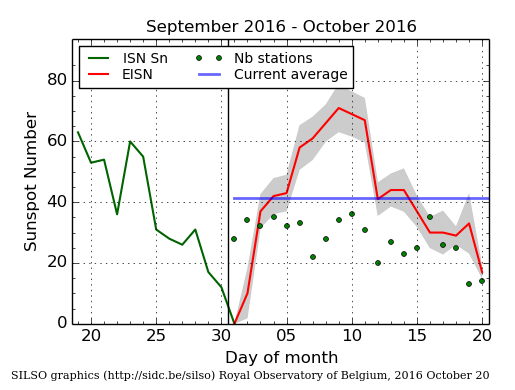
The daily Estimated International Sunspot Number (EISN, red curve with shaded error) derived by a simplified method from real-time data from the worldwide SILSO network. It extends the official Sunspot Number from the full processing of the preceding month (green line). The plot shows the last 30 days (about one solar rotation). The horizontal blue line shows the current monthly average, while the green dots give the number of stations included in the calculation of the EISN for each day.
Review of geomagnetic activity
The news of the week was the passage of the October 9 CME which arrived earlier than expected. It came with a weak shock visible in the solar wind at 21:22UT October 12. The solar wind speed did not go above 450 km/s. From 5:30UT, October 13 the magnetic field displayed in a clear way the passage of the magnetic cloud with total magnetic field increasing first sharply then gently to a maximum of 25 nT near midnight October 14/15.
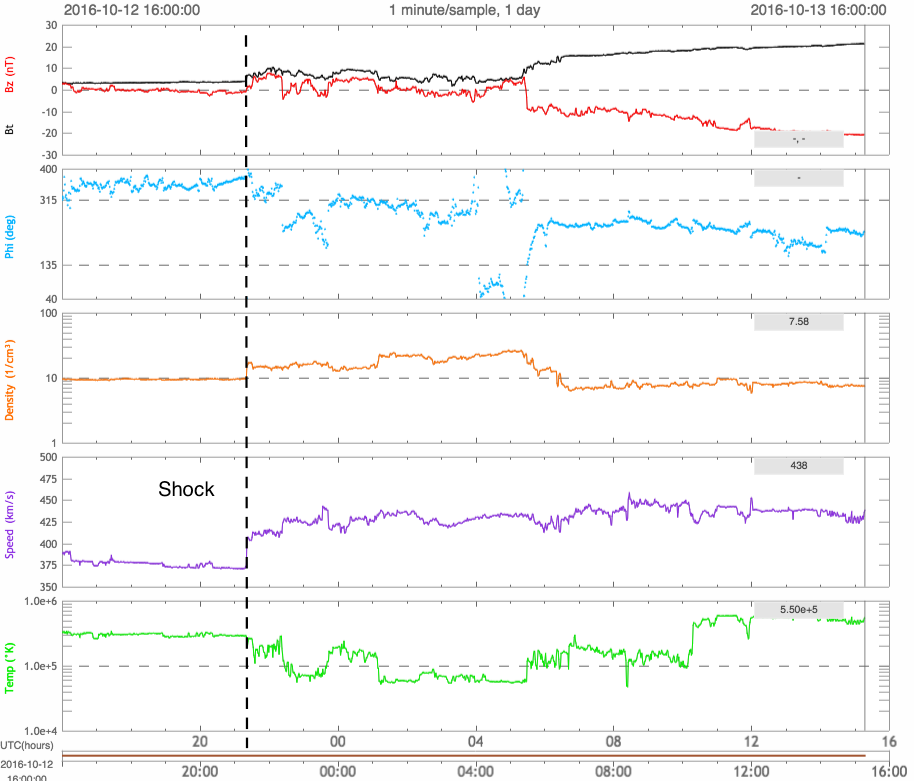
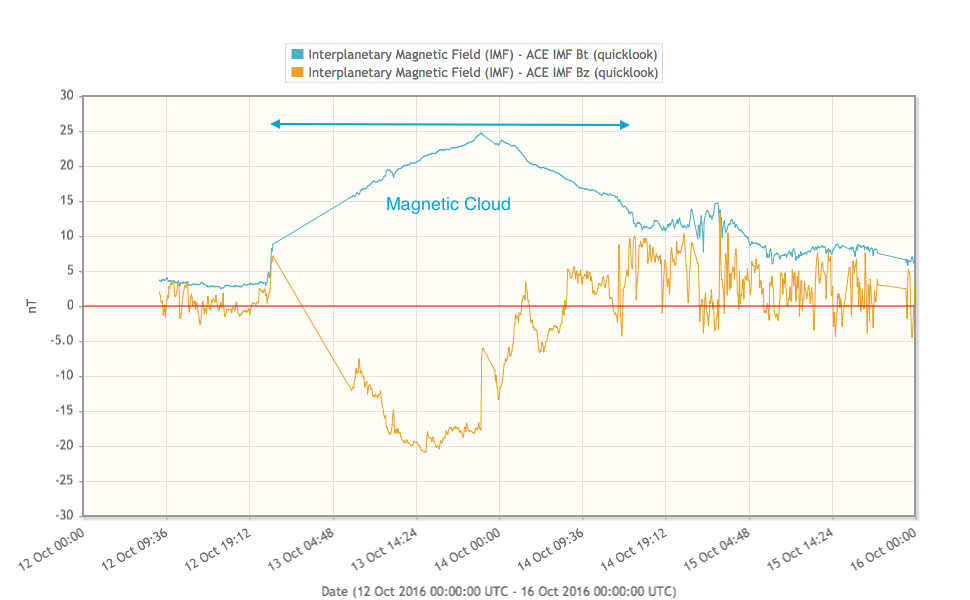
The magnetic field Bz component was negative for the entire period reaching a maximum value of -21nT. As evident from the Bz and phi angle evolution a very gentle rotation of the magnetic field was observed with the passage of the magnetic cloud.
After the CME passage, solar wind parameters remained slightly elevated before solar wind speed rose to values of 750 km/s by the end of the week due to recurrent negative polarity coronal hole influence.
Geomagnetic conditions were at minor to moderate storm level (NOAA Kp 6 , local K dourbes 5) during the entire passage of the CME and reached minor storm levels under the high speed stream influence.
Review of ionospheric activity (10 Oct 2016 - 16 Oct 2016)
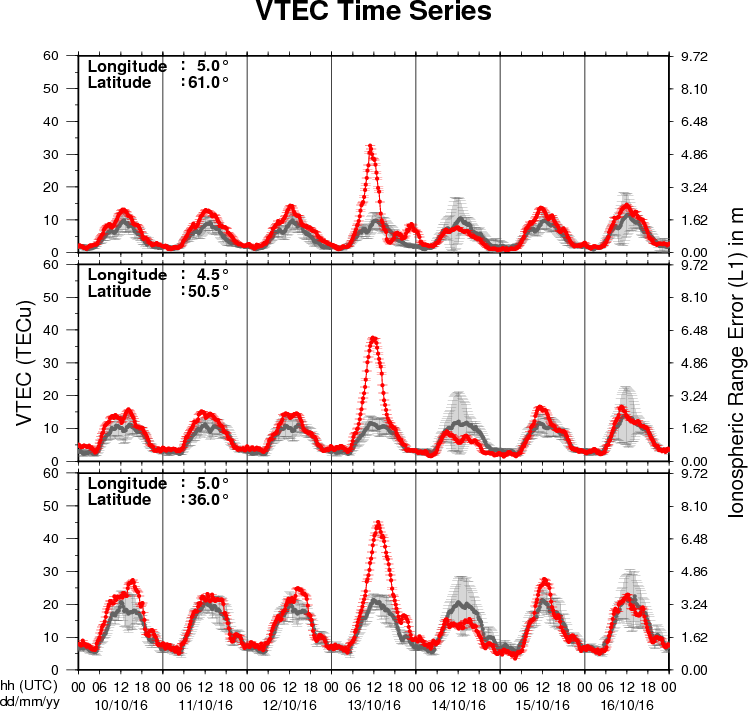
The figure shows the time evolution of the Vertical Total Electron Content (VTEC) (in red) during the last week at three locations:
a) in the northern part of Europe(N61°, 5°E)
b) above Brussels(N50.5°, 4.5°E)
c) in the southern part of Europe(N36°, 5°E)
This figure also shows (in grey) the normal ionospheric behaviour expected based on the median VTEC from the 15 previous days.
The VTEC is expressed in TECu (with TECu=10^16 electrons per square meter) and is directly related to the signal propagation delay due to the ionosphere (in figure: delay on GPS L1 frequency).
The Sun's radiation ionizes the Earth's upper atmosphere, the ionosphere, located from about 60km to 1000km above the Earth's surface.The ionization process in the ionosphere produces ions and free electrons. These electrons perturb the propagation of the GNSS (Global Navigation Satellite System) signals by inducing a so-called ionospheric delay.
See http://stce.be/newsletter/GNSS_final.pdf for some more explanations ; for detailed information, see http://gnss.be/ionosphere_tutorial.php
Future Events
For more details, see http://www.spaceweather.eu/en/event/future
4th Asia Oceania Space Weather Alliance (AOSWA) Workshop, in Jeju, Republic of Korea
Start : 2016-10-24 - End : 2016-10-27
Website:
http://aoswa4.spaceweather.org/index.php
Global Modelling of the Space Weather Chain in Helsinki, Finland
Start : 2016-10-24 - End : 2016-10-28
This event brings together solar, heliospheric, magnetospheric,
and ionospheric communities to discuss the current state and future
challenges in global modelling of the entire space weather chain.
Major developments in forecasting space weather, and understanding
the effects of solar eruptions requires increased communication and
collaboration of these often rather distinct communities. We
welcome submissions from these modelling communities and also
synergetic studies utilising both observations and numerical
models.
Website:
https://pnst.ias.u-psud.fr/sites/pnst/files/global_modelling_space_weather_oct2016.pdf
European Space Weather Week in Ostend, Belgium
Start : 2016-11-14 - End : 2016-11-18
The ESWW is the main annual event in the European Space Weather
calendar. It is the European forum for Space Weather as proven by
the high attendance to the past editions. The agenda will be
composed of plenary/parallel sessions, working meetings and
dedicated events for service end-users. The ESWW will again adopt
the central aim of bringing together the diverse groups in Europe
working on different aspects of Space Weather.
Website:
http://www.stce.be/esww13/
4th SOLARNET Meeting: The Physics of the Sun from the Interior to the Outer Atmosphere, in Lanzarote (Spain)
Start : 2017-01-16 - End : 2017-01-20
The IV SOLARNET MEETING 'The physics of the Sun from the
interior to the outer atmosphere' will take place in Lanzarote
(Spain) from 16th to 20th of January 2017, organized by the
Instituto de AstrofÃsica de Canarias (IAC).
SOLARNET (High-resolution Solar Physics Network) is an EU-FP7
project coordinated by IAC with the aim of bringing together and
integrating the major European research infrastructures in the
field of high-resolution solar physics. SOLARNET involves all
pertinent European research institutions, infrastructures, and data
repositories. Networking activities, access to first-class
infrastructures and joint research and development activities are
being covered under SOLARNET to improve, in quantity and quality,
the service provided by this European community.
The purpose of this conference is to provide a coherent picture
of the Sun as a single physical system playing all the underlying
physical processes measured and observed in the solar atmosphere to
date.
Website:
http://www.iac.es/congreso/solarnet-4meeting/
Solar Orbiter Workshop 7: Exploring the solar environs in Granada, Spain
Start : 2017-04-03 - End : 2017-04-06
This event will be hosted by the Instituto de Astrofisica de
Andalucia - CSIC. Please mind that on April 7th the 20th SWT
meeting will take place at the same venue.
Website: Unkown
